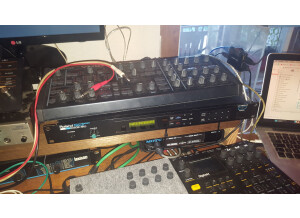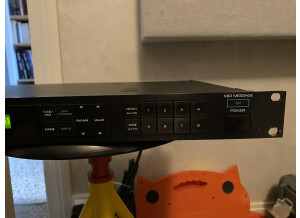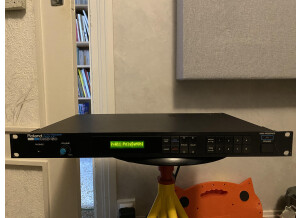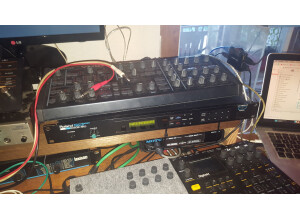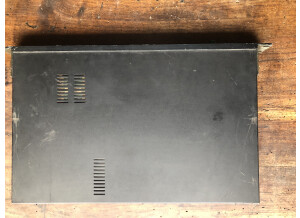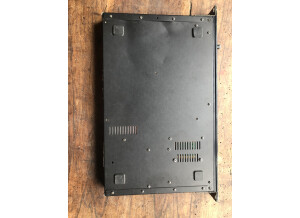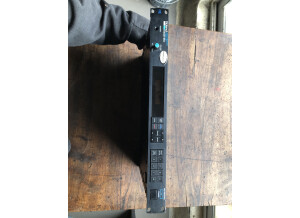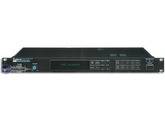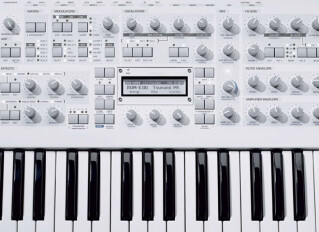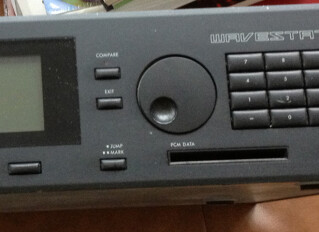MKS-50 classified ad
Alerte nouvelle annonceImages
Videos
Reviews
4.4/5(7 reviews)
71 %
14 %
Write a user review
Classic Synth Sounds!
Published on 08/02/15 at 14:24This has been a rock-solid piece of gear in my studio for a long time. No repairs needed except for changing the battery
PROS:
Performance Patch settings
Small 1U rackmount footprint
The sounds are Hooverlicious!
Excellent support site with info and 1000's of free Tone downloads http://llamamusic.com/mks50/mks-50.html
CONS:
Tones are difficult to program without an external programmer. Software (CTRLR) or hardware (PG-300, KIWI)
The prices on eBay are always too high for this model
PROS:
Performance Patch settings
Small 1U rackmount footprint
The sounds are Hooverlicious!
Excellent support site with info and 1000's of free Tone downloads http://llamamusic.com/mks50/mks-50.html
CONS:
Tones are difficult to program without an external programmer. Software (CTRLR) or hardware (PG-300, KIWI)
The prices on eBay are always too high for this model
00
»
Limited but good and original
Published on 08/16/12 at 12:24 (This content has been automatically translated from French)Released in 1987, MKS 50 is the rack version of Alpha Juno, the youngest of the family of JUNOS, polyphonic analog synthesizers based on a COD through. The architecture of the engine sound is pretty standard and limited to essentials. However, specific points give it a well-marked. The single oscillator has interesting waveforms corresponding to different variations of the usual square and saw-tooth, with support for PWM. Although this is not a second oscillator itself, there is a sub-oscillator is used to enlarge the sound in the bass. The instrument features a high-pass filter, a 24dB/octave low-pass filter and an LFO with a good range of frequencies. Also included is an original...…
Read more
Released in 1987, MKS 50 is the rack version of Alpha Juno, the youngest of the family of JUNOS, polyphonic analog synthesizers based on a COD through. The architecture of the engine sound is pretty standard and limited to essentials. However, specific points give it a well-marked. The single oscillator has interesting waveforms corresponding to different variations of the usual square and saw-tooth, with support for PWM. Although this is not a second oscillator itself, there is a sub-oscillator is used to enlarge the sound in the bass. The instrument features a high-pass filter, a 24dB/octave low-pass filter and an LFO with a good range of frequencies. Also included is an original envelope rather than 7 parameters. Finally, the sound can be coated with the famous chorus of Roland at the time.
The rack itself is very robust and MIDI driver in a very satisfactory manner. The instrument is sensitive to velocity and aftertouch, allowing a game very much alive. Memory is 128 sounds, which is twice the keyboard version.
UTILIZATION
Usability is not the strong point of the machine. Already the Alpha JUNO jobs disappeared in favor of the knobs obscure numeric buttons and scroll wheel famous "Alpha Dial", with the MKS 50 is lost even this last and we are left to use her fingers to draw by pressing heart's content on the pushbuttons or wheezing! In addition, Roland honored us distinguish between "patch" and "tone" which is quite cumbersome to handle and cut into 8 banks do not facilitate the work with program changes. In short, this is not the joy ...
I put it though the average because it is rather well with MIDI control. You can program the sounds via software or as a controller and you do not touch the rack too, it's still bearable! The advantage is that with such use, he should be able to still work for many years.
SOUNDS
I like the sound of 50 MKS. It is true that this synth may sound like the analog of the poor, compared to other previous JUNOS and even sounding a bit more "round". But say it is worse would be unfair, I would say it is different. I suspect Roland have tried to take its range analog to the sounds of the Yamaha DX7 FM and Alpha Juno as JX8P are the best examples: the sound is clearer, brighter, thinner. The MKS 50 inherited this tendency. It will never be the best machine for the big analog sound standard, but it can produce a singular and very interesting. I love the smoothness of the water enhanced by the sub-oscillator and chorus. At higher frequencies, it is highly crystalline. At the same time, do not believe that it gets in lace: it can produce low-impact, well just look at his famous "hoover", his specialty, he has to know the belly.
To illustrate all this, I have created a small demo (based mainly on presets): http://www.arts21.net/fr/french-roland-mks-50
OVERALL OPINION
I can not say I appreciate this synthesizer for ergonomics or to the extent of its possibilities as sound on these two aspects, it is rather limited. I love it for its original sounds that have both the analog and the presence of a very particular subtlety that remains unmatched. It is rather difficult to describe, it obviously depends on personal taste and the music he wants to produce.
The rack itself is very robust and MIDI driver in a very satisfactory manner. The instrument is sensitive to velocity and aftertouch, allowing a game very much alive. Memory is 128 sounds, which is twice the keyboard version.
UTILIZATION
Usability is not the strong point of the machine. Already the Alpha JUNO jobs disappeared in favor of the knobs obscure numeric buttons and scroll wheel famous "Alpha Dial", with the MKS 50 is lost even this last and we are left to use her fingers to draw by pressing heart's content on the pushbuttons or wheezing! In addition, Roland honored us distinguish between "patch" and "tone" which is quite cumbersome to handle and cut into 8 banks do not facilitate the work with program changes. In short, this is not the joy ...
I put it though the average because it is rather well with MIDI control. You can program the sounds via software or as a controller and you do not touch the rack too, it's still bearable! The advantage is that with such use, he should be able to still work for many years.
SOUNDS
I like the sound of 50 MKS. It is true that this synth may sound like the analog of the poor, compared to other previous JUNOS and even sounding a bit more "round". But say it is worse would be unfair, I would say it is different. I suspect Roland have tried to take its range analog to the sounds of the Yamaha DX7 FM and Alpha Juno as JX8P are the best examples: the sound is clearer, brighter, thinner. The MKS 50 inherited this tendency. It will never be the best machine for the big analog sound standard, but it can produce a singular and very interesting. I love the smoothness of the water enhanced by the sub-oscillator and chorus. At higher frequencies, it is highly crystalline. At the same time, do not believe that it gets in lace: it can produce low-impact, well just look at his famous "hoover", his specialty, he has to know the belly.
To illustrate all this, I have created a small demo (based mainly on presets): http://www.arts21.net/fr/french-roland-mks-50
OVERALL OPINION
I can not say I appreciate this synthesizer for ergonomics or to the extent of its possibilities as sound on these two aspects, it is rather limited. I love it for its original sounds that have both the analog and the presence of a very particular subtlety that remains unmatched. It is rather difficult to describe, it obviously depends on personal taste and the music he wants to produce.
See less
321
»
Published on 04/03/12 at 07:22 (This content has been automatically translated from French)
The MKS-50 is the version of expander JUNO-1 and α 2, 1U rack.
Monotimbral - Polyphonic 6 channels, 1 through COD.
128 sounds - 128 patches - memories of 16 agreements
16 character LCD
Connectors: MIDI In, Out and Thru - output jack 6.35 L, R and headphones - jacks tape backup.
UTILIZATION
As for versions keyboards, the use is simple. No sub-menus: a PARAM button. To scroll through the general settings, or patches of tone and a VALUE knob to change them. It is also editable by the programmer Sysex PG-300, PC vendors and EZ-Alpha PG300emu, control surfaces ...
The MKS-50 has some advantages over the Juno-1 and α 2:
- It has patches that are a combination of sound (tone)...…
Monotimbral - Polyphonic 6 channels, 1 through COD.
128 sounds - 128 patches - memories of 16 agreements
16 character LCD
Connectors: MIDI In, Out and Thru - output jack 6.35 L, R and headphones - jacks tape backup.
UTILIZATION
As for versions keyboards, the use is simple. No sub-menus: a PARAM button. To scroll through the general settings, or patches of tone and a VALUE knob to change them. It is also editable by the programmer Sysex PG-300, PC vendors and EZ-Alpha PG300emu, control surfaces ...
The MKS-50 has some advantages over the Juno-1 and α 2:
- It has patches that are a combination of sound (tone)...…
Read more
The MKS-50 is the version of expander JUNO-1 and α 2, 1U rack.
Monotimbral - Polyphonic 6 channels, 1 through COD.
128 sounds - 128 patches - memories of 16 agreements
16 character LCD
Connectors: MIDI In, Out and Thru - output jack 6.35 L, R and headphones - jacks tape backup.
UTILIZATION
As for versions keyboards, the use is simple. No sub-menus: a PARAM button. To scroll through the general settings, or patches of tone and a VALUE knob to change them. It is also editable by the programmer Sysex PG-300, PC vendors and EZ-Alpha PG300emu, control surfaces ...
The MKS-50 has some advantages over the Juno-1 and α 2:
- It has patches that are a combination of sound (tone) and different settings: volume, portamento, pitch bend value, detune, key range, MIDI controls, game mode (Poly, Mono, Chord Memory )
- The 128 memory patches and tones are fully editable (no ROM).
Mono, absent on the Juno 1 and 2, can control the MKS with a guitar MIDI converter. In this mode, the MKS behaves as 6 mono synths playing the same sound on six consecutive MIDI channels. Besides the single player game, this feature can seem trivial for a keyboardist, but it actually allows one to simulate unison mode voices from February to June. And the effects obtained with portamento or pitch bend, independent voice for each, can be surprising and interesting.
SOUNDS
The sound generator is identical (architectural components) than α JUNO-1 and 2. It has a section COD combining different types of waveforms PULSE SAWTOOTH, SUB and NOISE. Its envelope generator allows more elaborate forms a classic ADSR.
Most acoustic sounds that do not deserve some attention here. But I rather like the organ, some EP, melodic percussion and strings especially. The MKS is much more comfortable in the artificial sounds: pads and tablecloths, sweeps, bass, FX. His palette of tones will sound quite "dirty" to sounds very soft and changeable.
I invite you to read my opinion on the JUNO-2 for more details.
OVERALL OPINION
Quite versatile, it's a rack that I recommend for its range of sounds still relevant and easily integrated. Its synthesis is simple, easy to understand for a beginner, but accomplished. Its Mono particular extends the possibilities of a device generally monotimbral.
I am a sick man: I have two MKS-50 in addition to my JUNO-2. Although I love their sound and I use them a lot, it is by chance that I have acquired: 30 and 50 € of MKS-50 eyes that make you sweet, it can not refuse. In view of its rating, the MKS-50 seems more desirable than its counterparts JUNO 1 and 2: this is justified by the lack of keyboard to clean, compact (there is finally some racks analos 1U), and its features additional.
Sometimes I combine my 2 MKS on the same channel to draw complex sounds. I really appreciate this grain uncertain, warm and vibrant that I have never found on digital synths.
Monotimbral - Polyphonic 6 channels, 1 through COD.
128 sounds - 128 patches - memories of 16 agreements
16 character LCD
Connectors: MIDI In, Out and Thru - output jack 6.35 L, R and headphones - jacks tape backup.
UTILIZATION
As for versions keyboards, the use is simple. No sub-menus: a PARAM button. To scroll through the general settings, or patches of tone and a VALUE knob to change them. It is also editable by the programmer Sysex PG-300, PC vendors and EZ-Alpha PG300emu, control surfaces ...
The MKS-50 has some advantages over the Juno-1 and α 2:
- It has patches that are a combination of sound (tone) and different settings: volume, portamento, pitch bend value, detune, key range, MIDI controls, game mode (Poly, Mono, Chord Memory )
- The 128 memory patches and tones are fully editable (no ROM).
Mono, absent on the Juno 1 and 2, can control the MKS with a guitar MIDI converter. In this mode, the MKS behaves as 6 mono synths playing the same sound on six consecutive MIDI channels. Besides the single player game, this feature can seem trivial for a keyboardist, but it actually allows one to simulate unison mode voices from February to June. And the effects obtained with portamento or pitch bend, independent voice for each, can be surprising and interesting.
SOUNDS
The sound generator is identical (architectural components) than α JUNO-1 and 2. It has a section COD combining different types of waveforms PULSE SAWTOOTH, SUB and NOISE. Its envelope generator allows more elaborate forms a classic ADSR.
Most acoustic sounds that do not deserve some attention here. But I rather like the organ, some EP, melodic percussion and strings especially. The MKS is much more comfortable in the artificial sounds: pads and tablecloths, sweeps, bass, FX. His palette of tones will sound quite "dirty" to sounds very soft and changeable.
I invite you to read my opinion on the JUNO-2 for more details.
OVERALL OPINION
Quite versatile, it's a rack that I recommend for its range of sounds still relevant and easily integrated. Its synthesis is simple, easy to understand for a beginner, but accomplished. Its Mono particular extends the possibilities of a device generally monotimbral.
I am a sick man: I have two MKS-50 in addition to my JUNO-2. Although I love their sound and I use them a lot, it is by chance that I have acquired: 30 and 50 € of MKS-50 eyes that make you sweet, it can not refuse. In view of its rating, the MKS-50 seems more desirable than its counterparts JUNO 1 and 2: this is justified by the lack of keyboard to clean, compact (there is finally some racks analos 1U), and its features additional.
Sometimes I combine my 2 MKS on the same channel to draw complex sounds. I really appreciate this grain uncertain, warm and vibrant that I have never found on digital synths.
See less
151
»
Opinion Patch
Published on 03/01/12 at 01:42 (This content has been automatically translated from French)I do not have an MKS-50 Alpha but Juno2.
I just want to make some corrections to other reviews:
- Attention to the confusion: multiple waveforms does not necessarily mean more oscillators! In this case, the Juno does not have COD 3 but only one. The thing is that it can generate a rectangle (pulse) and a saw-tooth (Saw) simultaneously. With a sub-oscillator for low noise and a more present. But still: it is only one oscillator! It therefore does not possess the features made possible with more COD (VCO): detune, transpose, FM, sync, ring and cross modulation, ... ... ... For example, the series JX (JX-3P, JX-8P ...) have 2 COD them.
- The envelope generator is not an ADSR (as the...…
I just want to make some corrections to other reviews:
- Attention to the confusion: multiple waveforms does not necessarily mean more oscillators! In this case, the Juno does not have COD 3 but only one. The thing is that it can generate a rectangle (pulse) and a saw-tooth (Saw) simultaneously. With a sub-oscillator for low noise and a more present. But still: it is only one oscillator! It therefore does not possess the features made possible with more COD (VCO): detune, transpose, FM, sync, ring and cross modulation, ... ... ... For example, the series JX (JX-3P, JX-8P ...) have 2 COD them.
- The envelope generator is not an ADSR (as the...…
Read more
I do not have an MKS-50 Alpha but Juno2.
I just want to make some corrections to other reviews:
- Attention to the confusion: multiple waveforms does not necessarily mean more oscillators! In this case, the Juno does not have COD 3 but only one. The thing is that it can generate a rectangle (pulse) and a saw-tooth (Saw) simultaneously. With a sub-oscillator for low noise and a more present. But still: it is only one oscillator! It therefore does not possess the features made possible with more COD (VCO): detune, transpose, FM, sync, ring and cross modulation, ... ... ... For example, the series JX (JX-3P, JX-8P ...) have 2 COD them.
- The envelope generator is not an ADSR (as the J106) but a 4-segment envelope. The difference is negligible pa: an ADSR has 4 parameters (ADSR. ..) while that of Juno (and therefore the MKS) possesses 7 (T1/L1, T2/L2, T3/L3, T4). The possibilities are not the same!
UTILIZATION
Without PG-300, the editing is done via the alpha dial. It is less friendly than buttons on a J106 but this is all at attainable.
I personally did not need the manual for the part editing sounds'.
on the other hand, such as editing MIDI is done with Sysex, MIDI charter at the end of manual suddenly becomes indispensable.
SOUNDS
The sounds are actually typical of this type of machine (analog polyphonic mid-80's at a tilt).
That is to say, quite nice, absolutely not realistic, but always enough typed in its place the pieces in need of synthetic sounds.
I like tablecloths, pads, some E-Pianos and some bass. All sounds 'imitators' (realistic sound) for my taste are just bad and difficult to use, often as electronic sounds ...
On the other hand, today, those who want realistic sounds that will provide more than one pattern Juno ...
OVERALL OPINION
Whether the Juno or the MKS, it is excellent ... in his field!
I have other analogue machines (J106, Oberheim Matrix-6, Yamaha CS15, Kawai K3M), a lot of digital (K2000, TG77, Wavestation, R3, SuperNova, ...) and, anyway, my Ju- 2 is always helpful to me: it has a little 'je ne sais quoi' of its own and pushes me to always use it, almost like new!
I just want to make some corrections to other reviews:
- Attention to the confusion: multiple waveforms does not necessarily mean more oscillators! In this case, the Juno does not have COD 3 but only one. The thing is that it can generate a rectangle (pulse) and a saw-tooth (Saw) simultaneously. With a sub-oscillator for low noise and a more present. But still: it is only one oscillator! It therefore does not possess the features made possible with more COD (VCO): detune, transpose, FM, sync, ring and cross modulation, ... ... ... For example, the series JX (JX-3P, JX-8P ...) have 2 COD them.
- The envelope generator is not an ADSR (as the J106) but a 4-segment envelope. The difference is negligible pa: an ADSR has 4 parameters (ADSR. ..) while that of Juno (and therefore the MKS) possesses 7 (T1/L1, T2/L2, T3/L3, T4). The possibilities are not the same!
UTILIZATION
Without PG-300, the editing is done via the alpha dial. It is less friendly than buttons on a J106 but this is all at attainable.
I personally did not need the manual for the part editing sounds'.
on the other hand, such as editing MIDI is done with Sysex, MIDI charter at the end of manual suddenly becomes indispensable.
SOUNDS
The sounds are actually typical of this type of machine (analog polyphonic mid-80's at a tilt).
That is to say, quite nice, absolutely not realistic, but always enough typed in its place the pieces in need of synthetic sounds.
I like tablecloths, pads, some E-Pianos and some bass. All sounds 'imitators' (realistic sound) for my taste are just bad and difficult to use, often as electronic sounds ...
On the other hand, today, those who want realistic sounds that will provide more than one pattern Juno ...
OVERALL OPINION
Whether the Juno or the MKS, it is excellent ... in his field!
I have other analogue machines (J106, Oberheim Matrix-6, Yamaha CS15, Kawai K3M), a lot of digital (K2000, TG77, Wavestation, R3, SuperNova, ...) and, anyway, my Ju- 2 is always helpful to me: it has a little 'je ne sais quoi' of its own and pushes me to always use it, almost like new!
See less
110
»
Audio excerpts
-
00:0002:04

Tech. sheet
- Manufacturer: Roland
- Model: MKS-50
- Series: MKS
- Category: Analog Synth Racks/Sound Modules
- Added in our database on: 04/29/2002
MKS-50 HOMEPAGE (Patches, Tones, Utilities, Info, DIY's and Reference Materials)
http://llamamusic.com/mks50/mks-50.html
- Type: Synth / Rack Module
- Oscillators: 1 DCO Per Voice: Pulse - Sawtooth - Sub - Noise Waveforms And 1 Sub Oscillator
- Envelopes: Seven Parameter ADSR Envelopes For Filter And Amp
- Filter: 24db Analog Lowpass Filter
- Polyphony: 6 Voices
- Effects: Portamento - 16 Chord Memories - Transpose - Chorus
- Keyboard: None
- Control: MIDI w/Velocity, Aftertouch And Dynamics Mappable To VCF or ENV
- Patches / Tones: 128 / 128
- Audio Outs: 2 (Left - Right)
- Headphone Out: Yes
- MIDI Out: 1
- MIDI In: 1
- MIDI Thru: 1
- Date Produced: 1986
- Comments about the sounds: Hooverlicious!
»
Manuals and other files
Other categories in Synthesizers/Racks/Modules
Other names: mks 50, mks50




